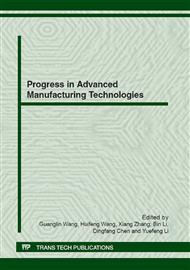p.3
p.8
p.13
p.17
p.21
p.26
p.31
p.36
Abrasive Wear Performance of Hot-Dipping Al-Mn Alloy Coatings on Q235
Abstract:
The Q235 steel was modified by hot-dip-aluminizing technique, and Al-Mn alloy layer was obtained on the steel surface. Scan electron microscopy (SEM), X-ray diffraction (XRD) and abrasive wear tester were used to investigate the microstructure and wear performance of the Al-Mn alloy coatings. The results show that the surface of the obtained pure aluminum coatings is acicular, while blocks Al-Mn compounds phase exists in Al-Mn alloys layer, and the Al-Mn alloy layer is composed of Al, FeAl3, Fe2Al5 and MnAl6 phases. The experimental results showed that wear weight loss of aluminum coating is more than Q235 steel. However, after manganese added to the aluminum, Al-Mn alloy coating abrasion wear loss of weight far below the Q235 steel and aluminum coating. And weight loss increases along with Mn content decreases. When worn after 100 h, Al-13% wtMn wear alloy coating weight loss of 45% of Q235 steel, aluminum coating of 35%. So the hot-dipping Al-Mn alloy layer has excellent abrasive wear resistance.
Info:
Periodical:
Pages:
13-16
Citation:
Online since:
August 2012
Authors:
Keywords:
Price:
Сopyright:
© 2012 Trans Tech Publications Ltd. All Rights Reserved
Share:
Citation:


